I’M AN INGRATE, AND RUTHLESS WITH FRUITLETS
Great Asparagus Does Not Require A Green Thumb
Not to be an ingrate or a braggart, but the asparagus some friends recently brought over for our shared dinner didn’t compare with my home-grown asparagus. Not that the friends’ asparagus wasn’t good. Theirs came from a local farm, so I assume harvest was within the previous 24 hours. 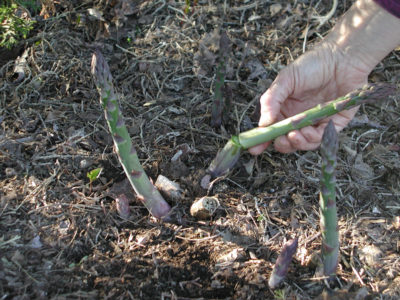 But the stalks of my asparagus are snapped off the plants within 100 feet of the kitchen door, clocking in at anywhere from a few minutes to an hour of time before they’re eaten. It’s not my green thumb that makes my asparagus taste so good. It’s the fact that I can harvest it within 100 feet of my kitchen door.
But the stalks of my asparagus are snapped off the plants within 100 feet of the kitchen door, clocking in at anywhere from a few minutes to an hour of time before they’re eaten. It’s not my green thumb that makes my asparagus taste so good. It’s the fact that I can harvest it within 100 feet of my kitchen door.
But don’t take my word for it. Research has shown that asparagus spears begin to age as soon as they’re picked, the stalks toughening and sugars disappearing, and bitterness, sourness, and off-flavors beginning to develop. Yum.
Taste is just one of the many reasons to plant asparagus. Here’s more: Deer and other wildlife leave it alone so it doesn’t need to be corralled within a fence; the ferny foliage that needs to be let grow after harvest ends in early July makes a soft green backdrop for colorful flowers; a planting can pump out stalks from the end of April till the end of June (around here) for decades.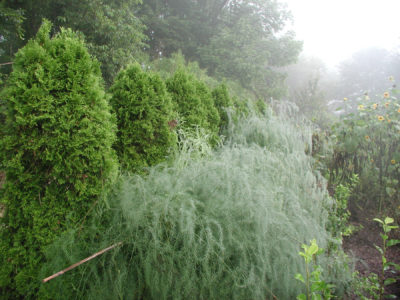
Asparagus’s two potential problems are relatively minor. The first is asparagus beetle, a beetle whose eggs, which look like black specks on the stalks, hatch into slug-like young that feed on the stalks. I keep this bugger in check by picking every single stalk — even spindly, inedible ones — every time the bed is harvested. The beetle, then, has nowhere to lay her eggs. (Not in my bed, least; she can seek out some wild asparagus here and there.) And then, at the end of the season, I cut down all the browned, ferny foliage and cart it over to the compost pile, in whose depths the adults, some of which overwinter in the old stalks, meet their demise.
No pesticides, organic or otherwise, have ever been sprayed on my asparagus, so natural predators also can do their share of making asparagus beetles a non-issue. Hand-picking beetles and larvae, which I’ve never had to resort to, is another way to keep the beetles in check. (My ducks may have a “hand” in that.)
Weeds are the other potential problem in an asparagus bed. One of the worst weeds in any bed is . . . asparagus! Each red berry dangling from the stems of a female asparagus plant houses a number of seeds that, once they hit ground level, can sprout to make new plants. The cure is to plant an all male variety of asparagus, such as Jersey Giant or Jersey Prince.
Unfortunately, a package of an all male variety can contain a few females. So, in addition to planting an all male variety, the cure for weeds is straightforward: Weed! I keep my bed regularly weeded during harvest season, then only occasionally weeded once fronds start to make the bed almost impenetrable.
Off With The Fruitlets (Some, At Least)
The slow but steadily increasing warmth this spring has been ideal for tree fruits (not so much the rainy weather). A bumper crop of fruitlets perch on branches of my apple and pear trees. It’s time to remove most of them.
These plants are genetically programmed to set more fruits than they could possibly have the energy to ripen. Spring presents many hazards to those blossoms, including killing freezes and insect pests. So, come June, when some of these threats have passed, fruit trees naturally shed excess developing fruitlets. But not enough.
The trees’ goals are to make seeds to make new trees. The seeds are enclosed within fruits that appeal to wildlife, who then help disperse the seeds. Those fruits might be good enough for wildlife, but not for you and me. For larger and more flavorful fruits, even more need to be removed than are shed by the “June drop.” Only 5 to 10 percent of apple blossoms need to set fruit for a full crop.
So I’m spending some time pinching or snipping off excess fruitlets, saving those that are largest and most free from blemishes, with a few inches between those that are left.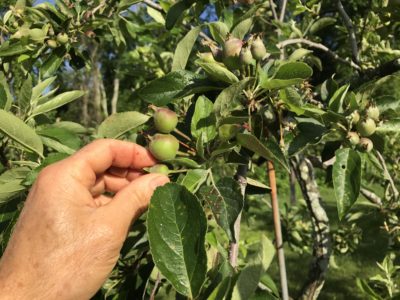
Fruit thinning is not only for flavor. A large crop one year bodes for a small crop the following; fruit thinning evens out any feast and famine cycle. The thinning also reduces some pest problems caused by fruits hanging too close to each other.
Pros And Cons Of Bad Weather (For Humans)
The recent spate of rainy weather has been accompanied by cool temperatures, which some plants enjoy and others wait out. Peas, cabbage, kale, and radishes are having a grand old time; sweet corn and beans wait out the cool weather. 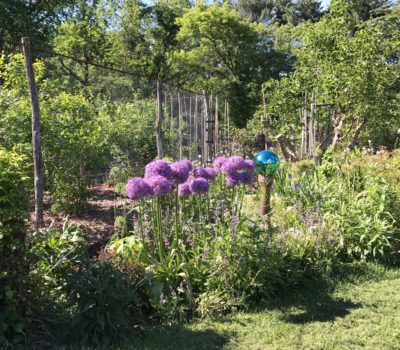 The most dramatic response has been in the delphiniums, dames rockets, and giant alliums. With cool temperatures, their colorful displays go on and on.
The most dramatic response has been in the delphiniums, dames rockets, and giant alliums. With cool temperatures, their colorful displays go on and on.
Asparagus doesn’t mind hot or cool weather. The cool weather does slow down spear production, which made for insufficient harvest to share the day my friends came to dinner.

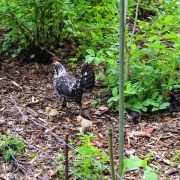

Hi Lee, thanks for your article! Wondering what you do to keep your asparagus ferns from falling over in a heap? Mine are in an 8′ x 4′ raised bed at the edge of my garden and are falling down from the wind. Thinking that next year I need to put in some stakes and use some twine somehow? Was curious how you handled this? Thanks!
Yes, stakes and twine. Or just let them droop.
I love my asparagus and am so glad I made the effort five? six? years ago, planting the Jersey. I think I may have a female because I have seen the occasional berry. Good tips on Asparagus beetle. I have to change my ways to avoid any beetle problems, thank you.
I have an asparagus bed, 3 or 4 years old, and I’ve had those little red berries you speak of. I’d like to weed the bed as you suggest, but I’m not exactly sure what I should be weeding. I understand why, just don’t understand what. Can you explain a little more?
Anything in the bed except the asparagus plants that you planted are weeds. Pull thm all out.
Hi Lee, back in 2013 I planted some Jersey Supreme and Purple passion, the jersey are real thin and the heads fan out quickly. The purples about 2 feet away grow very good. MY question is are these thin jerseys ever going to get going or should i dig them up and try something different? It seems I am wasting time fert and water on them and they are not improving. Thanks
Over harvesting or less than ideal soil conditions would cause roots to have less energy, leading to spindly sprouts. Here, I stop harvest by the end of June. Plants need full sun and rich soil. Perhaps let the plants grow for a year without any harvesting to build up energy reserves. And check growing conditions.